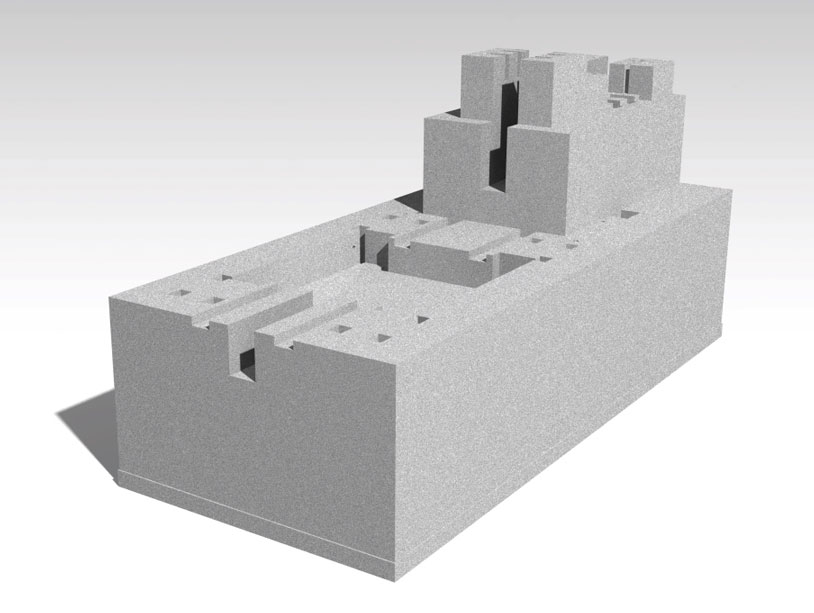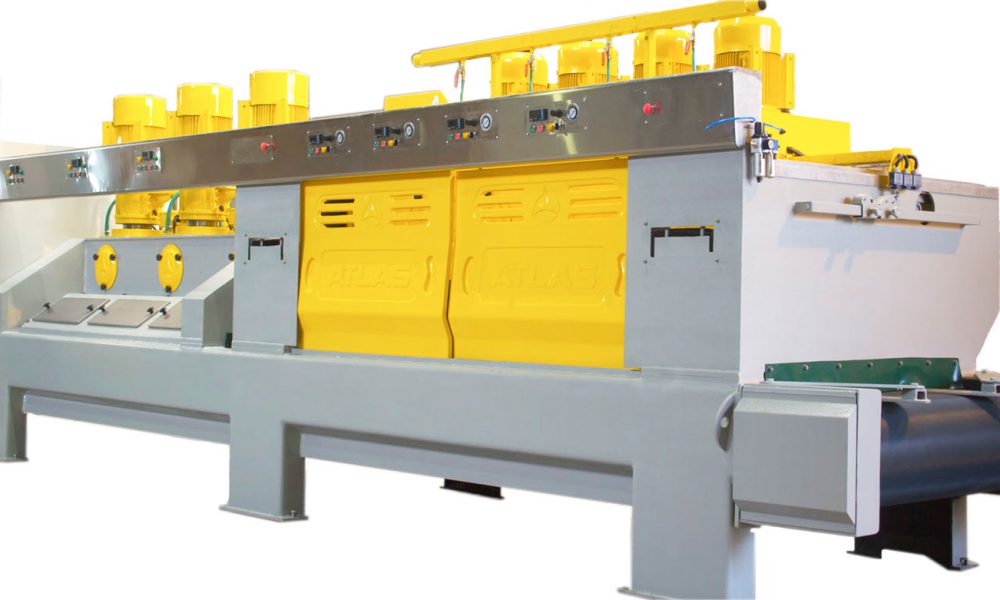REINFORCEMENT Foundation of Gang saw
Projects

Before installing the device, the exact implementation of the foundation of this device is necessary, which is one of the most sensitive parts of the saw machine, due to the blows caused by the movement of the frames of the blades, which are transmitted to the bearings of the saw and to the bearings to the foundation of the saw. Therefore, the foundation of the saw should have a high strength against the impact and be able to repel blows. The performance of the foundation of the saw must be in accordance with the drawing provided by the manufacturer of device, because the foundation drawing of different saws are different and cannot be installed on each other.
All stages of the performance of the foundation have their own special sensitivity. That you can see the various stages as bellow:
- First stage : Digging
The meaning of digging, is excavation of the ground is from the base level to the desired depth. The initial visit of the place to verify the location of the excavation by an experienced expert is due to the proper positioning, soil hardness and other necessary conditions. For the protection of the body, the Chinese block is placed and the floor of the cavity is poured into the “lean concrete” (lean concrete is a low grade of cement, which is poured below the foundation. Usable cement in concrete, is 100 to 150 kg per cubic meter.)
- Second stage: Reinforcement
Armature is one of the most sensitive and precisely concrete parts of the building, because the tensile forces in the concrete structure are tolerated by the Reinforcement. In this regard, the performance of reinforcement of concrete structures should be implemented with ultimately accurate and best mood.
The suitable roof covering should be performance for the foundation, so that the reinforcement is not exposed to rain or moisture.
Note that reinforcement is specialized work, its strict monitoring by experienced experts is very necessary.
Important Notes on reinforcement:
- Do not use rust or oil-filled armature, and should be cleaned if they are dirty.
- All of the reinforcement should be cut by special scissor and should not be cut by the air cutter.
- Avoid bending reinforcements at temperatures below 5 ° C. To bend and re-shape, all the reinforcement must be cold and do it by mechanic device.
- The clearance between the reinforcements to the mold surface should be 3 to 5 cm long, so that the concrete cover on the reinforcement has appropriate thickness. This also protects the rust and corrosion of the reinforcement by creating a bond between the concrete and the reinforcement.
- All reinforcements must be bent at a radial angle, which is coordinated with the steel material of reinforcement.
- It is possible to increase the length of the rebar if it is needed to increase the length of the rebar by patching and adding the rebar, but it should be noted this increasment should be constant during the rebar, the desired value can be calculated according to the available
- Third stage: Molding
To construct a reinforced concrete structure, fresh concrete should be poured into the molds to form the shape after filling the entire volume and tightening. Therefore, in the construction of concrete structures, the molding is important. Once the molds are in place, they have to be inspected and the seams that will probably spill out the concrete will fill up. The molds should be very strong and well-holden. Longitudinal and transverse bolts and reinforcements are needed to increase the stability and durability of molds and scaffolds.
In the case of wooden molds, they should pay attention to their water absorption. These molds should be completely greasy and lubricated before concrete.
To create the location of the bolt box, the unit is used with ionolite, which should be mounted on the three-layer board, and then placed in the desired location, so that it can be easily detached and cleaned. After casting, the expert must confirm their molding and dimensions.
- Stage Four: Concreting
Concreting process in various conditions and climates depending on air condition is different.
In general, concreting has the following steps:
Before starting of the concreting process, the specifications of the location should be in accordance with the drawings, technical specifications and the standard.
The most important steps to check the conformity is in accordance with the following:
1- Control the closing of the reinforcements
2- Control of the diameter, number and spacing of the reinforcements
3- Using spacer rebar under and around the reinforcements
4- Clean the surface of the lean concrete, the molds and also the rebar
5- Control the distance of axle-to-axle
6- Control the dimensions of the foundation
7- Controlling the level of concrete
Concrete step is after the controls are done, that ready concrete is used for gang saw machine.
Prior to preparing the concrete, a sample of the soil and aggregates, sand, and lubricant additives are examined to verify the laboratory’s report for the materials used for concrete. In this type of concrete, all construction work is carried out in the center of the concreting site, and concrete is made with a mixer truck and shipped to the workstation with a fixed camera.
About 500 to 600 tons of concrete is required for the foundation of the saw, which is used with a 350 degree concrete for concreting in the hole and a 400-degree concrete for mounting in the upper molds that hold the bearings.
The transport of concrete should be such that no significant changes can be made in the time intervals, the water to cement ratio, the slump, the air temperature and, ultimately, the uniformity of the concrete.
At the site of concreting, one of the most important of equipment is the vibrating device. Due to the high volume of the foundation concreting of the saw, requires at least five vibration machines with at least two substitutes to ensure the correct result is necessary. It is essential to ensure the performance of the vibrating devices before starting work.
- As noted above, due to different atmospheric conditions, the process of concreting will change. If the concreting is in cold weathering, have antifreeze, heating equipment for heating water and if necessary the materials, concrete products such as nylon, sack, fiberglass and …, is essential.
- Sampling:
When performing concrete operations, concrete sampling must be performed by an authorized laboratory representative approved by the supervisor of the manufacturer of the saw.
After sampling, samples are kept for at least 24 hours and then shipped to the laboratory. During the first 24 hours, appropriate care and maintenance of the samples, including non-displacement, impact and inappropriate coating, are of special importance.
- Stage Five: Molding
The needed time for molding, from time of concreting until the separating the mold in different situations and atmospheric conditions is necessary. The mold should be removed when the concrete is able to withstand tensions and deformation. This period depends on the type of concrete used, the weather, the environmental condition of the site and the manner in which the concrete is to be used.
Molding operations should be done step by step, without impact and pressure, so that the body of the concrete is not subjected to sudden loads and concrete does not suffer damage. After separating the mold, it must be prevented from contacting any things with concrete structures for some time.
- According to the points concerned, it is important to note that all stages and processes of foundation must be under the supervision and trusted experts.

